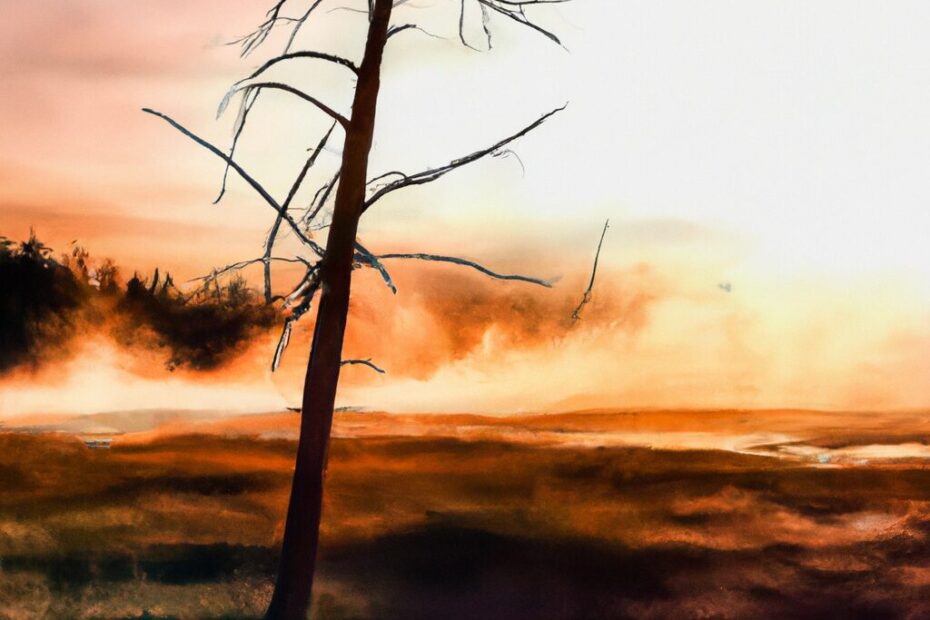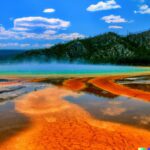Have you ever wondered how geysers, those fascinating natural wonders, actually erupt? In this article, we will explore the inner workings of geysers, from the three key components that make them unique to the triggers that set off their powerful eruptions.
We will also delve into the different stages of a geyser eruption, the factors that influence their frequency, and the dangers of approaching them during an eruption. We will discuss how scientists study and monitor geyser activity using advanced technologies. Let’s uncover the mysteries of these awe-inspiring geothermal features together.
What Is a Geyser?
A geyser is a hydrothermal system that periodically erupts, releasing thermal energy in the form of superheated water and steam.
These natural phenomena are characterized by their intermittent eruptions, which are driven by the build-up of pressure within underground chambers filled with hot water. The mechanics of geysers involve a delicate balance between the incoming groundwater and the confined chambers that allow for this pressure to increase until it overcomes the resistance of the surface. Geological features such as fault lines and thermal conduits play a vital role in the formation and sustainability of geysers, facilitating the movement of hot water upwards from the Earth’s depths to create the spectacular displays we witness.
How Does a Geyser Erupt?
A geyser erupts when pressure builds up underground due to the heating of subsurface water beyond its boiling point.
This pressure build-up occurs as superheated water becomes trapped beneath the surface, creating a cyclical pattern known as the eruption cycle. As the water heats up, steam is produced, further contributing to the pressure within the geyser chamber. Eventually, the pressure becomes so intense that it forces its way through the geyser’s vent, resulting in a powerful eruption of steam and water. The mechanics of geyser activity involve a delicate balance of heat, pressure, and water, creating these natural spectacles that captivate onlookers with their raw energy and beauty.
What Are the Three Key Components of a Geyser?
The three key components of a geyser include its mechanics for eruption, the water reservoir where pressure builds, and the heat source that superheats the water.
The mechanics of a geyser are crucial in enabling its spectacular eruptions. When underground water reaches boiling temperatures, steam and hot water are forced through the geyser’s vent. The water reservoir plays a vital role in storing the water that undergoes heating and pressure accumulation. This stored water, coupled with the intense heat source beneath the surface, creates the conditions necessary for the geyser to release its pent-up energy in a dramatic display of nature’s power.
What Triggers a Geyser Eruption?
A geyser eruption is triggered by various factors, including volcanic activity, geological features, and the accumulation of pressure below the surface.
Volcanic activity plays a crucial role in heating the underground water reservoirs that feed geysers. As magma rises towards the Earth’s crust, it heats the water trapped in porous rocks, creating pressurized pockets. Geological formations, such as fault lines and fractures, act as conduits for this superheated water to travel upwards. The build-up of pressure occurs when the water reaches a critical temperature and pressure point where it rapidly expands, forcing its way to the surface in a spectacular display of boiling water and steam. This process showcases the dynamic interplay between the chemistry of geysers, geothermal processes, and the Earth’s powerful forces.
What Causes the Water to Heat Up?
Water in a geyser heats up primarily due to contact with thermal energy originating from deep within the Earth’s crust, often associated with nearby magma chambers.
As this hot subterranean water rises towards the surface, it passes through geological formations known as geothermal reservoirs, where it absorbs additional heat from the surrounding rock. The process of thermal energy transfer within these reservoirs is a result of the intense tectonic activity occurring beneath the Earth’s surface. This interaction between the heated water, geological structures, and tectonic forces creates the conditions necessary for the spectacular eruptions that characterize geysers, showcasing the powerful forces at play within our planet.
What Role Does the Pressure Play?
Pressure within a geyser is instrumental in forcing superheated water and steam to rise towards the surface before an eruption occurs.
As the pressure builds up beneath the Earth’s surface, the superheated mixture of water and steam becomes highly energized, seeking any available pathway to release its pent-up force. The intense pressure acts as a driving force, propelling the water and steam upwards through natural fissures and channels. Once the critical steam pressure surpasses the resistance of the overlying rocks and sediments, the geyser erupts, unleashing a spectacular display of boiling water and steam into the air.
How Does the Constriction of the Geyser’s Vent Contribute to the Eruption?
The constriction of a geyser’s vent and conduit, often lined with silica deposits, plays a crucial role in directing the explosive release of steam and water during an eruption.
This design feature not only influences the force and direction of the eruption but also contributes to the formation of geyserite, a mineral deposit composed mainly of silica. As the superheated water rises through the conduit, it dissolves silica from the surrounding rocks, which later precipitates out as geyserite when the water reaches the surface. These silica-rich deposits build up over time, shaping the vent and conduit, and affecting the flow dynamics during eruptions. The presence of geyserite around the vent can also influence the height and frequency of eruptions based on how it modulates pressure within the geyser’s plumbing system.
What Are the Different Stages of a Geyser Eruption?
A geyser eruption typically progresses through distinct stages, starting with the build-up stage, followed by the main eruption stage, and concluding with the steam phase.
During the build-up stage, there is a noticeable increase in water temperature within the geyser chamber as pressure builds up below the surface. This phase is characterized by intermittent splashes and minor bursts of water as the geyser prepares for the main eruption.
As the pressure reaches a critical point, the geyser enters the main eruption stage, where a powerful column of water and steam is expelled into the air, sometimes reaching impressive heights.
Following the explosive release of water, the geyser transitions into the steam phase, with the remaining steam dissipating into the surroundings, signaling the end of the eruption cycle.
The Build-Up Stage
During the build-up stage of a geyser eruption, subtle signs may indicate the increasing pressure and frequency of eruptions, attracting interest from geothermal exploration efforts.
One common observation is the rise in water temperature within the geyser’s vent as underground heat intensifies, causing the water to become more volatile. The geyser pool may experience fluctuations, with the water level sometimes increasing as pressure builds up below the surface. These indicators, along with seismic activity around the geyser, are closely monitored by geologists and researchers using specialized equipment like seismometers and thermal cameras, providing valuable insights into the geyser’s behavior and eruption patterns.
The Main Eruption Stage
The main eruption stage of a geyser showcases the spectacular release of superheated water and steam, often characterized by distinct patterns based on the geyser basin, eruptive cycle, and geyser type.
During this phase, the geyser behavior is influenced by various factors such as the size and shape of the underground reservoir, the intensity of heat sources beneath the Earth’s surface, and the geological formations surrounding the geyser vent. These unique features play a crucial role in determining the height, duration, and frequency of the eruptions.
Different geyser types, including fountain geysers, cone geysers, and perpetual spouters, exhibit diverse eruption patterns, adding to the fascinating dynamics of these natural wonders.
The Steam Phase
The steam phase of a geyser eruption is marked by intense steam explosions, offering researchers an opportunity to observe temperature variations and behavior patterns of the geyser.
During this phase, the geyser releases a powerful combination of scalding steam and water, reaching incredible heights as it bursts forth from the earth with tremendous force. Researchers closely monitor the temperature changes preceding these eruptions, analyzing the buildup of pressure and heat within the geyser’s chamber. By studying the behavior of the geyser during the steam phase, scientists gain valuable insights into the underlying mechanisms driving these hydrothermal phenomena, shedding light on the complex interactions between water, heat, and geological structures.
Why Do Some Geysers Erupt More Frequently Than Others?
The frequency of geyser eruptions varies due to a combination of geologic processes, regional conditions, and the unique characteristics of geysers worldwide.
Geological processes play a crucial role in the formation and maintenance of geysers. For instance, the presence of underground reservoirs of hot water, combined with heat generated by magma beneath the Earth’s surface, creates the ideal conditions for geyser activity. The global distribution patterns of geysers are influenced by tectonic plate movements and volcanic activity, which can trigger eruptions. The diverse features observed in geysers, such as cone shape, vent structure, and water temperature, also impact their eruption frequency. Understanding these factors is essential for predicting and studying geyser behavior.
What Factors Affect the Frequency of Geyser Eruptions?
The frequency of geyser eruptions is influenced by various factors, including geyser activity patterns, underlying geological structures, and predictive modeling techniques.
Geyser activity patterns play a crucial role in determining the intervals between eruptions, with some geysers exhibiting more regular schedules while others are more unpredictable. The underlying geological structures, such as the presence of faults and fractures, impact the pathways of water and steam that lead to eruptions. Predictive modeling techniques utilize data on past eruptions, geothermal features, and external factors like weather patterns to forecast potential geyser behavior, aiding in understanding and possibly predicting when the next eruption might occur.
What Are the Dangers of Approaching a Geyser During an Eruption?
Approaching a geyser during an eruption poses significant dangers, including exposure to scalding steam, potential steam explosions, and risks associated with the underlying supervolcano activity.
The geologic formations surrounding geysers can be unstable during eruptions, leading to landslides and falls. Supervolcanic activity beneath the geyser can result in sudden shifts in the ground, increasing the likelihood of injuries. Steam explosions, a common occurrence during geyser eruptions, can propel rocks and debris at high velocities, posing a severe threat to anyone nearby. The intense heat and pressure of the steam can cause severe burns and respiratory issues, highlighting the extreme hazards of getting too close to a geyser in full eruption.
How Do Scientists Study and Monitor Geyser Eruptions?
Scientists employ various technologies to study and monitor geyser eruptions, utilizing advanced tools for geyser research and continuous monitoring of geyser behavior.
- These methodologies often include remote sensing techniques such as satellite imagery to track changes in geyser activity over large geographical areas.
- Ground-based sensors are strategically placed near geyser sites to capture real-time data on temperature, pressure, and seismic activity, offering valuable insights into the underlying processes that trigger geyser eruptions.
- By combining data from multiple sources, researchers can create algorithms that predict potential eruptions, enhancing our understanding of these natural phenomena and their significance in geothermal landscapes.
What Technologies Are Used to Monitor Geyser Activity?
Advanced technologies, including thermal anomaly detection and behavior analysis tools, are pivotal for predicting geyser eruptions and understanding the underlying mechanisms governing geyser behavior.
These technological tools play a crucial role in monitoring geyser activity and ensuring early warnings regarding potential eruptions. Eruption prediction systems, for instance, analyze patterns in temperature and pressure to foresee any imminent volcanic events with greater accuracy. Thermal anomaly detection devices help in identifying irregular heat signatures, indicating changes in the underground thermal dynamics of geysers. Behavior analysis tools evaluate geyser conduct, such as water flow rates and eruption intervals, offering insights into the cyclical nature of geyser eruptions and aiding in long-term trend analysis.
Last Updated on February 7, 2024 by Jon Waraas – Originally Posted: February 7, 2024

I’m Jon Waraas, and I’ve been navigating the online world since 2006. By day, I’m the proud owner of some eCommerce gems, and by night, I’m the voice behind the adventures on Waraas.Com.
My heart, however, belongs to the wild beauty of Yellowstone National Park. I’ve got a collection of websites dedicated to sharing the wonders of this natural masterpiece. Oh, and did I mention? I’m currently building my own cabin inside the ghost town of Gilmore, Idaho – a cabin with tales to tell!
When I’m not immersed in the digital realm, you’ll find me lacing up my boots for a good hike or setting up camp under the star-studded sky.




